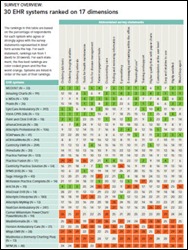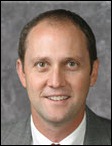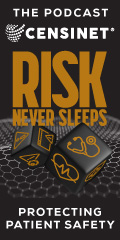The primary point of using the Cloud is using operating expenses vs limited capital ones and avoiding having to update…
News 7/22/11
![]() Athenahealth will acquire Proxsys, a Birmingham, AL-based vendor of front-end revenue cycle tools that include medical necessity checking, insurance verification, pre-certification, referrals, and facility scheduling. The all-cash deal is worth up to $36 million. Athenahealth says it will use Proxsys technology in its newly announced athenaCoordinator service, which will move patient and insurance information between hospitals and their affiliated physician practices in return for a per-transaction fee. ATHN shares are up almost 10% Thursday in after-hours trading following the release of positive Q2 numbers and news of the acquisition. Share price has nearly doubled in the past year, giving the company a $1.69 billion market cap.
Athenahealth will acquire Proxsys, a Birmingham, AL-based vendor of front-end revenue cycle tools that include medical necessity checking, insurance verification, pre-certification, referrals, and facility scheduling. The all-cash deal is worth up to $36 million. Athenahealth says it will use Proxsys technology in its newly announced athenaCoordinator service, which will move patient and insurance information between hospitals and their affiliated physician practices in return for a per-transaction fee. ATHN shares are up almost 10% Thursday in after-hours trading following the release of positive Q2 numbers and news of the acquisition. Share price has nearly doubled in the past year, giving the company a $1.69 billion market cap.
Reader Comments
![]() From Scrambled CIO: “Re: software conversions. We are in the middle of a lot of system replacements and consolidation. I am amazed at the estimates and fees associated with a flat file conversion from SCC Soft Computer. Three hundred hours for a pathology conversion.” I assume you’re converting “from” rather than “to” SCC, in which case they have little incentive to give you a deal knowing you don’t have an option and your wounded former-customer indignation won’t matter anyway. It’s funny that I was describing exactly that scenario to someone at work today, where you’ve told your vendor that you’re dumping them down the road and they stop returning your calls and price everything at list-plus-larceny. It’s like an ugly divorce – if you had known how cold and vindictive your spouse could be, you’d have insisted on a pre-nup or maybe married someone else. But I don’t know the particulars in this case, so in fairness to SCC, I’ll just say “unverified” and assume there was a rationale for the price quoted.
From Scrambled CIO: “Re: software conversions. We are in the middle of a lot of system replacements and consolidation. I am amazed at the estimates and fees associated with a flat file conversion from SCC Soft Computer. Three hundred hours for a pathology conversion.” I assume you’re converting “from” rather than “to” SCC, in which case they have little incentive to give you a deal knowing you don’t have an option and your wounded former-customer indignation won’t matter anyway. It’s funny that I was describing exactly that scenario to someone at work today, where you’ve told your vendor that you’re dumping them down the road and they stop returning your calls and price everything at list-plus-larceny. It’s like an ugly divorce – if you had known how cold and vindictive your spouse could be, you’d have insisted on a pre-nup or maybe married someone else. But I don’t know the particulars in this case, so in fairness to SCC, I’ll just say “unverified” and assume there was a rationale for the price quoted.
![]() From Crabby: “Re: ARRA’s legacy. it will not be widespread adoption of EHRs. but rather the technical standards that ONC has laid out. They will do more for our industry, patient safety, and adoption than any sexy interface or legislation could ever do. Access to complete patient data across the continuum of care will be enough of a reward for a provider to login. Once logged in, we must make it easier for him/her to click the buttons than to bark at the nurse.” No one expected ARRA to be a panacea and fix all of HIT’s flaws, but incorporating standards should reap some benefits. Yep, there is still more work to do.
From Crabby: “Re: ARRA’s legacy. it will not be widespread adoption of EHRs. but rather the technical standards that ONC has laid out. They will do more for our industry, patient safety, and adoption than any sexy interface or legislation could ever do. Access to complete patient data across the continuum of care will be enough of a reward for a provider to login. Once logged in, we must make it easier for him/her to click the buttons than to bark at the nurse.” No one expected ARRA to be a panacea and fix all of HIT’s flaws, but incorporating standards should reap some benefits. Yep, there is still more work to do.
![]() From Jamie: “Re: Berk Smith. The Dell Healthcare VP/GM resigned Wednesday after 22 years at Perot Systems and Dell. He’s leaving for a startup.” Unverified. I e-mailed a Dell press contact, but haven’t heard back.
From Jamie: “Re: Berk Smith. The Dell Healthcare VP/GM resigned Wednesday after 22 years at Perot Systems and Dell. He’s leaving for a startup.” Unverified. I e-mailed a Dell press contact, but haven’t heard back.
![]() From Emily: “Re: 3M Health Information Systems. Another round of layoffs last week following another poor quarter of sales.” Unverified.
From Emily: “Re: 3M Health Information Systems. Another round of layoffs last week following another poor quarter of sales.” Unverified.
HIStalk Announcements and Requests
![]() Highlights from HIStalk Practice this week: the ever-witty and irreverent Dr. Joel Diamond reflects on technology over the past decade. Highlights from AAFP’s 2011 EHR User Satisfaction Survey. digiChart’s new CEO suggests the company is prepping itself to be acquired some day. Patients feel disrespected by their doctors. Canadian docs express familiar-sounding complaints about EMRs. Almost 70% of practices are looking to become a PCMH. In honor of Oscar de la Renta’s 79th birthday (or just because), feel free to sign up for the e-mail updates while you are checking out the hottest ambulatory HIT news.
Highlights from HIStalk Practice this week: the ever-witty and irreverent Dr. Joel Diamond reflects on technology over the past decade. Highlights from AAFP’s 2011 EHR User Satisfaction Survey. digiChart’s new CEO suggests the company is prepping itself to be acquired some day. Patients feel disrespected by their doctors. Canadian docs express familiar-sounding complaints about EMRs. Almost 70% of practices are looking to become a PCMH. In honor of Oscar de la Renta’s 79th birthday (or just because), feel free to sign up for the e-mail updates while you are checking out the hottest ambulatory HIT news.
![]() I am now on Google+, though I haven’t figured out what it’s going to give me that I don’t already have with Twitter, Facebook, and LinkedIn. However, if you feel the need to be in my circle, send me an invite.
I am now on Google+, though I haven’t figured out what it’s going to give me that I don’t already have with Twitter, Facebook, and LinkedIn. However, if you feel the need to be in my circle, send me an invite.
![]() Unrelated except to music fans: an influential but seldom-acknowledged musician of the 60s and 70s died this week. Grass Roots lead singer Rob Grill was 67. I actually saw them live well past their heyday in a bar holding maybe 25 fans and chatted with them while getting a beer. They still sounded good playing I’d Wait a Million Years, Temptation Eyes, Sooner or Later, and Midnight Confessions.
Unrelated except to music fans: an influential but seldom-acknowledged musician of the 60s and 70s died this week. Grass Roots lead singer Rob Grill was 67. I actually saw them live well past their heyday in a bar holding maybe 25 fans and chatted with them while getting a beer. They still sounded good playing I’d Wait a Million Years, Temptation Eyes, Sooner or Later, and Midnight Confessions.
![]() On the sponsor-only job board: Senior Enterprise Hospital Sales Executive, Senior C#/.NET Developer, Configuration Architect. On Healthcare IT Jobs: Informatics Analyst, Senior Systems Engineer – Windows Server Technology, Senior Director of Applied Clinical Informatics, Vice President of Client Services.
On the sponsor-only job board: Senior Enterprise Hospital Sales Executive, Senior C#/.NET Developer, Configuration Architect. On Healthcare IT Jobs: Informatics Analyst, Senior Systems Engineer – Windows Server Technology, Senior Director of Applied Clinical Informatics, Vice President of Client Services.
Acquisitions, Funding, Business, and Stock
athenahealth reports Q2 revenues of $77.9 million, up 33% from 2010. Non-GAAP adjusted net income was $7.9 million ($.22/share), compared to 2011’s $4.1 million. The company beat analysts’ estimates of $.18/share and revenues of $75.08 million.
![]() The provider of MyMedicalRecord PHR announces an agreement that gives a Chinese venture partner warrants to purchase up to four million shares of its stock. Sounds impressive until you notice the share price is $0.04, valuing the big international deal at $160,000.
The provider of MyMedicalRecord PHR announces an agreement that gives a Chinese venture partner warrants to purchase up to four million shares of its stock. Sounds impressive until you notice the share price is $0.04, valuing the big international deal at $160,000.
Private investment firm Veronis Suhler Stevenson acquires hospital financial analytics software vendor Strata Decision Technology, which claims 800 hospital customers that include Allina, Catholic Healthcare West, and Cleveland Clinic.
Express Scripts will acquire its prescription drug benefits competitor Medco in a $29.1 billion deal. The companies, whose combined revenue is $110 billion, say they’ll be able to lower costs and improve health with their combined drug purchasing power.
Microsoft’s Q4 numbers: revenue up 8%, EPS $0.69 vs. $0.51. beating consensus earnings estimates of $0.59. Windows revenue slipped for the third straight quarter, while Office revenue was up 8%.
Sales
Parkview Health (IN) signs an agreement with Streamline Health Solutions to upgrade six of its hospitals to accessANYware v1.9.
Northrop Grumman will partner with Verizon and Wellpoint subsidiary National Government Services to develop predictive modeling technology for CMS’s National Fraud Protection Program. CMS announced last month that it had awarded Northrop Grumman the $77 million fraud detection contract.
People
Clinical integration and search technology provider Apixio names Steve Roberts its VP of sales and Jenny Field its director of product marketing. Roberts is a former VP of sales for NextGen; Field was director of ambulatory medical informatics for Salinas Valley Healthcare System.
Former Healthland president and CEO James Burgess takes over as CEO for Advanced Health Media.
HFMA president and CEO Richard L. Clarke will retire on July 31, 2012.
Jason Bray is named CIO of Oklahoma State University Medical Center. He was previously CMIO of the OSU Center for Health Sciences.
Announcements and Implementation
Summa Health System (OH) deploys BIO-key’s fingerprint biometrics for authentication with Allscripts Sunrise Clinical Manager platform.
PHR vendor Dossia announces its Health Manager health management system, which it says will improve the health behaviors of its users through personalization involving games, social dynamics, incentives, and messaging. Dossia chair Craig Barrett says it represents the next generation of PHRs.
Government and Politics
![]() CHIME chimes in on proposed changes to HIPAA, saying the standards would be difficult for providers to meet and should be scaled back. CHIME claims the rules rely too much on technical capabilities that are not widely available and fail to acknowledge the amount of human intervention necessary to achieve compliance. Of particular concern is the proposed requirement for providers to create a consolidated report that documents all incidents of PHI access within a designated record set.
CHIME chimes in on proposed changes to HIPAA, saying the standards would be difficult for providers to meet and should be scaled back. CHIME claims the rules rely too much on technical capabilities that are not widely available and fail to acknowledge the amount of human intervention necessary to achieve compliance. Of particular concern is the proposed requirement for providers to create a consolidated report that documents all incidents of PHI access within a designated record set.
![]() The VA and Department of Defense were charged with developing overall integration between their organizations at a Chicago demonstration project for the first Federal Health Care Center, with some EHR integration due October 1, 2010 (single sign-on for clinical staff, single patient registration, and orders portability). A GAO report says they missed the date for the first two items but those are live now, but they’re struggling with lab orders. Pharmacy order integration has been “indefinitely delayed” and five pharmacists were hired to manually verify orders between the two systems and to check for drug-drug interactions. The GAO says they’re struggling because of the same old problems that always come up: “lack of an integrated and comprehensive project plan from VA and DoD.”
The VA and Department of Defense were charged with developing overall integration between their organizations at a Chicago demonstration project for the first Federal Health Care Center, with some EHR integration due October 1, 2010 (single sign-on for clinical staff, single patient registration, and orders portability). A GAO report says they missed the date for the first two items but those are live now, but they’re struggling with lab orders. Pharmacy order integration has been “indefinitely delayed” and five pharmacists were hired to manually verify orders between the two systems and to check for drug-drug interactions. The GAO says they’re struggling because of the same old problems that always come up: “lack of an integrated and comprehensive project plan from VA and DoD.”
Other
![]() The Women’s Health ABU at Cerner breaks out into a dancing flash mob during lunch at Cerner headquarters. Diners included Cerner associates, about 100 new hires, and over 40 clients. All I have to say is I want to be part of a dancing flash mob one day.
The Women’s Health ABU at Cerner breaks out into a dancing flash mob during lunch at Cerner headquarters. Diners included Cerner associates, about 100 new hires, and over 40 clients. All I have to say is I want to be part of a dancing flash mob one day.
![]() Core Health is running its annual HL7 Interface Technology Survey for CIOs/CTOs, IT managers, and HL7 professionals. They did a nice job last year. Respondents are entered in a drawing for a ThinkPad tablet.
Core Health is running its annual HL7 Interface Technology Survey for CIOs/CTOs, IT managers, and HL7 professionals. They did a nice job last year. Respondents are entered in a drawing for a ThinkPad tablet.
![]() Weird News Andy is on the tail of this story, which he summarizes as, “His butt, her end as a CNA.” A nursing assistant is fired from her job at a transitional care facility and faces voyeurism charges after taking pictures of a male patient’s buttocks, which she described to a co-worker as “too funny,” and posting them on her Facebook.
Weird News Andy is on the tail of this story, which he summarizes as, “His butt, her end as a CNA.” A nursing assistant is fired from her job at a transitional care facility and faces voyeurism charges after taking pictures of a male patient’s buttocks, which she described to a co-worker as “too funny,” and posting them on her Facebook.
![]() WNA also fell for this story from England: a disabled man who falls out of his wheelchair in a hospital’s parking garage just 100 yards from its ED has to wait 25 minutes for paramedics to be sent from the other side of London. A bystander claims hospital nurses refused to help and said they aren’t allowed to treat patients outside their areas, although a hospital spokesperson says no such rules exist and nurses have responded to garage emergencies previously.
WNA also fell for this story from England: a disabled man who falls out of his wheelchair in a hospital’s parking garage just 100 yards from its ED has to wait 25 minutes for paramedics to be sent from the other side of London. A bystander claims hospital nurses refused to help and said they aren’t allowed to treat patients outside their areas, although a hospital spokesperson says no such rules exist and nurses have responded to garage emergencies previously.
![]() Data integration software vendor Informatica and the IT division of Hospital Corporation of America are embroiled in a legal squabble over software license fees, with Informatica claiming HCA owes it $6.3 million following a license audit. HCA interprets the scope of its license differently and disputes the claim.
Data integration software vendor Informatica and the IT division of Hospital Corporation of America are embroiled in a legal squabble over software license fees, with Informatica claiming HCA owes it $6.3 million following a license audit. HCA interprets the scope of its license differently and disputes the claim.
![]() Cayman Islands Health Services Authority CIO Dale Sanders tells me that they’re re-competing their Cerner contract, with the core vendor tender here. If it were me, I’d plan the install for January and watch the resumes flood in from cold-haters more than willing to spend the winter there at discounted rates.
Cayman Islands Health Services Authority CIO Dale Sanders tells me that they’re re-competing their Cerner contract, with the core vendor tender here. If it were me, I’d plan the install for January and watch the resumes flood in from cold-haters more than willing to spend the winter there at discounted rates.
![]() A 34-year-old Australian woman who died immediately after visiting a physician for an ear infection is found by coroners to have experienced an allergic reaction to the antibiotic Ceclor, prescribed for her by an 85-year-old “computer illiterate” doctor who did not notice her documented allergy on the screen. The doctor has since given up his license and sought psychological counseling.
A 34-year-old Australian woman who died immediately after visiting a physician for an ear infection is found by coroners to have experienced an allergic reaction to the antibiotic Ceclor, prescribed for her by an 85-year-old “computer illiterate” doctor who did not notice her documented allergy on the screen. The doctor has since given up his license and sought psychological counseling.
![]() An indicted New Jersey couple who sold medical students and licensed physicians a $5,000 medical licensing exam test prep course that included stolen questions remains on the run, while their student-customers, most of them foreign medical school graduates, are being asked to defend their scores by re-test. Several have already failed and may lose their medical licenses. The National Board of Medical Examiners got suspicious when the wife took the USMLE exams several times and scored low, with a surveillance camera review showing her taking pictures of the computer monitor.
An indicted New Jersey couple who sold medical students and licensed physicians a $5,000 medical licensing exam test prep course that included stolen questions remains on the run, while their student-customers, most of them foreign medical school graduates, are being asked to defend their scores by re-test. Several have already failed and may lose their medical licenses. The National Board of Medical Examiners got suspicious when the wife took the USMLE exams several times and scored low, with a surveillance camera review showing her taking pictures of the computer monitor.
Researchers in Brazil find that tweets containing the word “dengue” correlate to local outbreaks of dengue fever, the disease that kills hundreds of people each year there, allowing authorities to identify geographic areas of outbreak and respond more quickly.
A 27-year-old hospital nurse in England is arrested after insulin was injected into IV bags in a storeroom, killing five patients.
Sponsor Updates
- Sunquest Information Systems hosted a “Build a Bike” team-building event at its user group meeting last week. Fifteen bikes were donated to local Tucson charities.
- United Regional Health Care System (TX) signs an enterprise license agreement for iSirona’s device connectivity solution.
- TELUS expands its Canadian EHR ecosystem with the connection of Optimed Software Corporation’s AccuroEMR to TELUS Health Space.
- CareTech Solutions announces that 14 of its clients were named Most Wired 2011 Hospitals. Five more were named Most Improved.
- Billian’s HealthDATA interviews Gail Donovan, EVP/COO of Continuum Health Partners about the economic challenge of providing high quality care and outcomes.
- Besler Consulting’s George Porette offers analysis on Medicare DSH and uncompensated care reimbursement in The Besler Beacon, the company’s quarterly newsletter.
- Awarepoint’s Q2 bookings beat 2010’s numbers, increasing its hospital client count to 153.
- Medicity’s Novo Grid is ranked the #1 private HIE solution by KLAS, the position it has held since the category was first reported last year.
- Porter Hospital (IN) will install the iConnect image operability solution from Merge Healthcare.
- Tulsa Spine and Specialty Hospital (OK) selects ProVation MD for physician point-of-care documentation.
- Jennifer Lyle, CEO of Software Testing Solutions, will serve as a Meaningful Use panel presenter at the iHT2 Health IT Summit in Denver next week.
- Southwest Mississippi Regional Medical Center chooses Wellsoft’s EDIS for its two hospitals.
- Thomson Reuters and CareEvolution expand their partnership to deliver the Thomson Reuter’s HIE Advantage solution, which leverages CareEvolution’s secure interoperability solutions and Thomson Reuters’ analytics expertise.
- The 40-provider Philadelphia Hand Center contracts for the SRS EHR.
EPtalk by Dr. Jayne
I was intrigued by the item in Monday’s Sponsor Updates regarding the Surescripts White Coat of Quality program. I have to admit not being familiar with it, but was able to find its Web site. Frankly, I’m surprised to see that only four vendors were given this recognition for 2010. To quote directly (including grammatical and spelling errors) from the Surescripts website:
The criteria for earning a White Coat in 2010 was, by design, very straight forward:
- Provide a signed commitment from company leadership affirming their organization’s commitment to quality.
- Measure quality metrics as specified in the published industry guidelines and report those metrics each month to Surescripts.
- Implement changes to software that address issues identified in quality reporting. Take steps to eliminate any issues measured in #2 above.
- Raise prescriber awareness through training.
As a provider, this seems like a slam-dunk. I’m not sure why more vendors aren’t on the list, especially some of the larger ones.
I was flipping through Health Data Management while watching HIPAA training and a McKesson ad aimed at independent physicians caught my eye. It grabs the reader with “I didn’t survive my residency to be an I.T. Manager” and says solutions are “arriving fall 2011.” The ad features an older gent with some pronounced hair loss.
To me, this ad seems aimed at either (a) physicians who are the last-ditch holdouts for putting off EHR implementation, or (b) those that hoped they could retire before someone forced them to bite the bullet and go electronic. Nothing new on the Web site, so I suspect this is just marketing rather than something truly transformational. Maybe it’s a discount for AARP members.
Speaking of independent spirits, a colleague cornered me in the doctor’s lounge waving an article on usability from American Medical News, reminding me how much he reveres his paper charts.
(I still don’t quite understand what the AMA is doing with this publication. They offer it in both print and digital versions, but the same article has different publication dates. I understand the Web version is going to come out before the snail mail version, but can’t we at least use the same dates, hmmm? This was dated June 20 online and July 11 in print for those of you who are playing along with the home game.)
Anyway, the article doesn’t tell us anything we don’t already know regarding usability. Guess what? Vendors are trying to reduce click counts, de-clutter screens, and save us from alert fatigue among other not-so-small feats like being certified for Meaningful Use, transitioning to 5010 and ICD-10, and so on.
The piece mentions CCHIT’s five-star usability rating as a tool some vendors use to differentiate themselves. Wondering if this is anything like the above-mentioned White Coat of Quality, I wanted more information. (I’ve been deployed on stable systems for some time and have a low tolerance for boastful sales practices, so it’s been a while since I’ve played the system / vendor selection game looking at it through the eyes of the average user.)
The CCHIT Web site seems clunky and vendors are not in alphabetical (or any other seemingly rational) order. I never did find a list of those products that had received the five-star usability rating, although a Google search brought up lots of individual vendor listings, many of products I wasn’t familiar with. Maybe my search skills are deteriorating or maybe it was the effects of too much fruit of the vine while watching what might be the saddest web-based HIPAA training I’ve ever seen in my life as I apply for staff privileges at a new hospital. Still looking for the list – can anyone help a girl out? E-mail me.

Contacts
Mr. H, Inga, Dr. Jayne, Dr. Gregg.


































































































@ Dr. Jayne
There is no list. You have to click on each 2011 CCHIT certified product
http://www.cchit.org/products/cchit/all/all/2011
and the usability rating will be displayed along with other product information.
CHIME is starting to be the group of NAYSAYERS – can’t do this, not enough time, to complicated, technology not there, blah, blah, blah. Hey Rich, maybe you should ask more CIO’s what they think, and give them real education to succeed, versus saying it’s “To Hard”. Gee people are you leaders or wimps! Roll up the sleeves and get it done!
Re 3M:
The PIG became a HOG 4-5 years ago and priced itself to where it underestimated the backlash that CFO’s would have someday.
Then 3M totally missed the mark for emerging technology in Computer Assisted Coding with a series of 3 progressively worse decisions the last 2 years around the use of NLP partners for their new CAC solution (1. no NLP /2. CodeWRONG / 3. CLU from Nuance which is really L&C and has never worked).
They are now laying in the bed they made for themselves. The industry is voting 3M off the HIM island. Without ICD10 the move would take 10 years. Because of ICD10 3M’s dominant HIM market share will be cone by this time next year. You don’t need a large sales team when you have lost the last 20 times in row you have competed for CAC.
A Harvard Business case study could truly be done on this one.
Does anyone see the irony in the 2011 CCHIT usability rating information having low usability